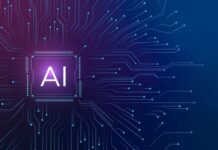Understanding on machines mimic humans is said to be the future agent where businesses and enablers foresees billion dollar opportunity. Artificial Intelligence (AI) technology briefs itself to be the potential business success regardless of applications and industries. With AI becoming more prominent it can define being an emblem on how human-machines co-exist bringing solution to complex problems. Combining the cognitive, emotional strengths of humans with that of machines will not bring cognizance just with software or services but a holistic chip-level advancement to determine AI in coming time.
Semiconductors Advancing With AI
Multiple industries and sectors are adopting AI vigorously. To bring these new architectures and capabilities of AI designers and innovators need high-performing AI chips (GPUs, FPGAs and ASICs), all coming and impacting the semiconductor industry.

Hence many leading semiconductor companies have already revamped their product fabrication processes matching the need of advance technologies like Artificial Intelligence (AI). Machine learning, neural network, support vector machines are used in processes like wafers defects inspection and classification, optical metrology, chip manufacturing, and modeling, photoresist contour prediction, semiconductor production result prediction, wafer process control and monitoring and so forth. Although their innovations in chip design and fabrication enabled next-generation devices, they received only a small share of the value coming from the technology stack—about 20 to 30 percent with PCs and 10 to 20 percent with mobile. Performing cognitive functions associated with human minds, such as perceiving, reasoning, and learning is bringing true value for semiconductor companies.
According to McKinsey Reports:
- AI could allow semiconductor companies to capture 40 to 50 percent of total value from the technology stack, representing the best opportunity they’ve had in decades.
- Storage will experience the highest growth, but semiconductor companies will capture most value in compute, memory, and networking.
- To avoid mistakes that limited value capture in the past, semiconductor companies must undertake a new value-creation strategy that focuses on enabling customized, end-to-end solutions for specific industries, or “microverticals.”
- Semiconductor companies could increase computational efficiency or facilitate the transfer of large data sets through memory and storage. For instance, specialized memory for AI has 4.5 times more bandwidth than traditional memory, making it much better suited to handling the vast stores of big data that AI applications require. This performance improvement is so great that many customers would be more willing to pay the higher price that specialized memory requires (about $25 per gigabyte, compared with $8 for standard memory).

Semiconductor Market With AI Entrant
We believe that the application of AI/ML will dramatically accelerate in the semiconductor industry over the next few years. Taking steps to scale up now will allow companies to capture the full benefits of these technologies. But the stakes are getting increasingly high. With each new technology node, expenses rise because research and design investments, as well as capital expenditures for production equipment, increase drastically as structures get smaller. For example, research and design costs for the development of a chip increased from about $28 million at the 65 nanometer (nm) node to about $540 million at the leading-edge 5 nm node (Exhibit 1). Meanwhile, fab construction costs for the same nodes increased from $400 million to $5.4 billion.
The story for semiconductor companies could be different with the growth of artificial intelligence (AI)—typically defined as the ability of a machine to perform cognitive functions associated with human minds, such as perceiving, reasoning, and learning. Many Artificial Intelligence applications have already gained a wide following, including virtual assistants that manage our homes and facial-recognition programs that track criminals. These diverse solutions, as well as other emerging AI applications, share one common feature: a reliance on hardware as a core enabler of innovation, especially for logic and memory functions.
Three in five semiconductor executives (37%) expect to move more than 40% of their workforce into new roles in the next three years, which will require substantial reskilling.
AI Trends
Hyperautomation
Hyperautomation is the combining of robotic process automation with artificial intelligence technologies. It’s frequently mentioned as a core aspect of the next wave of digital transformation, and it’s one of the coming AI trends of 2021. The power and utility of automation have long been known. The COVID-19 pandemic has only gone to showcase it further, as automation has proved instrumental in smoothing the disruption to office workflows. As an extension of automation, then, it makes sense that hyperautomation will grow even more into the spotlight.
Artificial intelligence of things (AIoT)
The artificial intelligence of things (AIoT) is the combination of the internet of things (IoT) and artificial intelligence. In other words, one of the 2021 AI trends will see the rise in our smart tech getting smarter.
With AIoT, internet-connected devices will be able to learn from the data they collect. Or understand your speech without shipping the data off to the cloud.
For instance, smart office technology will be able to not only detect who is in the office but make decisions about lighting and heating in order to save energy. Or, for a domestic example, an AIoT fridge will be able to scan its contents and suggest recipes using the food stored inside.
AI-enabled chips
Artificial intelligence functions need more processing power than non-AI functions. (AI tends to involve processing a lot more data.) This comes hand in hand with the ongoing exponential growth of processing power. And this continued growth and accessibility of AI-computing creates heightened demand for more powerful hardware. As such, the creation and supply of AI-enabled chips is set to be another of the leading AI trends in 2021. This hardware will be more efficient and enable increasingly widespread use of AI and automation functions.
Quantum AI
Leading organizations will start implementing quantum supremacy to calculate Qubits for use in supercomputers. Quantum computers resolve issues faster than traditional computers due to quantum bits. They also help in the analysis of data and the forecasting of many distinct patterns.
Quantum computers can assist a variety of companies in identifying difficult problems and predicting viable solutions. Future machines will also be capable of supporting a wide range of applications in fields such as healthcare, banking, and science.
AI-powered chatbots
Conversational AI, or AI-powered chatbots, improves the reach, accessibility, and personalization of the consumer experience. Conversational AI solutions, according to Forrester, result in improved customer service automation.
An AI-powered chatbot uses natural language processing (NLP) and machine learning to provide a more realistic, almost human level communication by better understanding what the human wants and requests.
Artificial Intelligence in India
According to a report by Accenture, artificial intelligence can possibly add US$957 billion, or 15% of India’s present gross value in 2035. The blend of the technology, information and ability that make intelligent systems possible has arrived to the critical mass, driving exceptional growth in AI investment.
Similarly as Google, Oracle, Microsoft, and Amazon are fighting to serve the cloud computing and machine learning needs of the US government, the following three to five years may cause a similar dynamic within India. As the Indian government pushes for digitization and sanctions more AI activities, private firms will run to win huge contracts– adding to the pool of assets to grow new technologies and turn out new AI and data science-related startups.
Some of the top jobs in AI (India – 2021) are as follows:
- Computational Philosopher – A computational philosopher is concerned with teaching human ethics and values in AI algorithms. For example, if a robot is being developed for doing household chores, it must be designed to listen and obey its employer’s commands.
- Robot Personality Designer – A dedicated robot personality designer designs a machine/robot’s digital persona.
- Robot Obedience Trainer – A robot obedience trainer is concerned with teaching the machine/robot to follow instructions and comply with the constraints. With more and more robots being introduced in houses, military strategies, etc., the future scope of Artificial Intelligence is bright.
- Autonomous Vehicle Infrastructure Designer – An autonomous vehicle designer develops autonomous vehicles’ digital interfaces that help them work independently. The bright Artificial Intelligence future scope can fuel the growth of autonomous vehicles in various industries.
- Algorithm Trainers / Click Workers – They work closely with AI algorithms and train them to recognize instructions, sentiments, moods, images, speech, etc. They train an AI algorithm to interact with their surroundings and take appropriate actions autonomously.
- AI Cybersecurity Expert – An AI cybersecurity expert develops algorithms that can identify a theft/risk associated with the system and take actions to eliminate it autonomously. Since new types of cyberattacks are evolving every day, AI is being used in cybersecurity to identify them. The future scope of Artificial Intelligence (AI cybersecurity) is also bright in the Asia Pacific region.

















